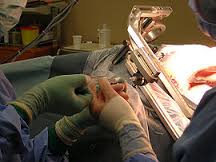Utility of fine-needle aspiration biopsy in abdominal tumors
Keywords:
Neoplasms, Abdominal neoplasms, Fine-Needel biopsy.Abstract
Introduction: intra-abdominal tumors are difficult to be diagnosed by aspiration biopsy; its combination with echography has not been described before in Mozambique
Objective: to report the experience of diagnosing intra-abdominal tumors by fine needle aspiration biopsy at the Central Hospital of Nampula, Mozambique.
Material and Method: a descriptive, retrospective study that included patients admitted in the hospital with tumors in the abdominal region or those referred from ambulatory services, the sample was comprised of patients undergoing fine-needle aspiration biopsy in the abdominal region. Preceding informed consent was requested, assessment for hospital admission and normal-necessary complementary tests. The variables were summed up using absolute frequencies and the relative in percentage terms.
Results: 113 patients underwent fine-needle aspiration biopsy, itemizing them positive, suspicious, negative of neoplastic cells along with those useless for the diagnosis. The greatest percentage corresponded to patients having a positive diagnosis (77, 9%); ages from 16-35 prevailed. Positive lesions (87, 6%) corresponded to hepatocellular carcinoma; nephroblastoma prevailed in patients under 15 years old.
Conclusions: fine-needle aspiration biopsy is an effective and economic method that associated with echography is very useful for the diagnosis and therapeutic of abdominal tumors. The greatest percentage of positive diagnosis corresponded with the age bracket of 16-55 years old, male sex predominated. The most important diagnoses were hepatocellular carcinoma, nephroblastoma and non-Hodgkin's lymphomas.
Downloads
References
1. Lester SC, Cotran RS. La mama. En: Cotran RS, Kumar V, Collins T. Robbins Patología Estructural y Funcional. 9ª ed. Madrid: Mc Graw-Hill. Interamericana; 2013. p. 1045-54.
2.Fletcher Ch. Diagnostico histopalógico de los tumores. 4ta ed. v-2. St. Louis: Mosby; 2008. p. 477-534.
3. Parrilla M, Lopez MV, Valls O. Atlas de ecocitopatología diagnóstica en las lesiones abdominales.La Habana, Cuba: Editorial Ciencias Médicas; 2006. p. 13-6.
4.. Kerl K, Oyen F, Leuschner I, Schneppenheim R, Nagel I, Siebert R, et al. Detection of SMARCB1 loss in ascites cells in the diagnosis of an abdominal rhabdoid tumor. Pediatr Blood Cancer [Internet]. 2015 May [citado 21 Ene 2016]; 62(5): 897-900. Disponible en: http://www.ncbi.nlm.nih.gov/pubmed/25663425
5. Margol AS, Judkins AR. Pathology and diagnosis of SMARCB1-deficient tumors. Rev Gastroenterol Mex [Internet]. 2014 Oct-Dec [citado 21 Ene 2016]; 79(4): 250-62. Disponible en: http://www.ncbi.nlm.nih.gov/pubmed/25246033
6. González Huezo MS, Sánchez Ávila JF, Asociación Mexicana de Hepatología, Asociación Mexicana de Gastroenterología, Sociedad Mexicana de Radiología e Imagen, Sociedad Mexicana de Oncología, et al. Mexican consensus on the diagnosis and management of hepatocellular carcinoma. Rev Gastroenterol Mex [Internet]. 2014 Jul-Sep [citado 21 Ene 2016]; 79(3): 171-9. Disponible en: http://www.ncbi.nlm.nih.gov/pubmed/25487133
7. Martinez Mier G, Esquivel Torres S, Medina Granados JP, Luna Castillo M, Castillo Chiquete R, Calzada Grijalva JF, et al. Presentation, staging, and outcome of patients with hepatocellular carcinoma at a center in Veracruz, Mexico. Oncol Rev [Internet]. 2015 Jul-3 [citado 21 Ene 2016]; 9(1): 274. Disponible en: http://www.ncbi.nlm.nih.gov/pubmed/25236795
8.Du T, Tan Z. Relations between deep venous thrombosis and inflammatory cytokines in postoperative patients with malignant abdominal tumors. Braz J Med Biol Res [Internet]. 2014 Nov [citado 06 Ene 2016]; 47(11): 1003–7. Disponible en: http://www.ncbi.nlm.nih.gov/pmc/articles/PMC4230292/
9. Xun Ze S, Jian Guo Z, Jian Jun W, Fang L. Clinical and computed tomography features of adult abdominopelvic desmoplastic small round cell tumor. World J Gastroenterol [Internet]. 2014 May-7 [citado 06 Ene 2016]; 20(17): 5157–64. Disponible en: http://www.ncbi.nlm.nih.gov/pmc/articles/PMC4009557/
10. Sastra SA, Olive KP. Protocol 1: Acquisition of tumor biopsies through abdominal laparotomy. Cold Spring Harb Protoc [Internet]. 2014 Jan [citado 06 Ene 2016]; 2014(1): 47–56. Disponible en: http://www.ncbi.nlm.nih.gov/pmc/articles/PMC4084730/
11. Pérez Tauriaux O, González Bernardo R. Tumor del estroma gastrointestinal de localización gástrica. Medisan [Internet]. 2015 Feb [citado 06 Ene 2016]; 19(2): 256-60. Disponible en: http://scielo.sld.cu/scielo.php?script=sci_arttext&pid=S1029-30192015000200015&lng=es&nrm=iso&tlng=es
12. León Acosta P, Ceballos Nápoles YJ, Pila Pérez R, Pila Peláez R. Carcinoma de corteza suprarrenal simulando un carcinoma renal. Reporte de caso. Gac Méd Espirit [Internet]. 2015 Dic [citado 06 Ene 2016]; 17(3): 149-59. Disponible en: http://scieloprueba.sld.cu/scielo.php?script=sci_arttext&pid=S1608-89212015000300016&lng=es
13. Rodríguez Rodríguez I, Borges Sandrino R, Barroso Rosales E, Santiesteban Pupo WE, Rodríguez Martínez YG, Casa de Valle Castro M. Hemangioma cavernoso del mesosigmoide: informe de un caso y revisión de la bibliografía. Rev Cubana Cir [Internet]. 2014 Mar [citado 06 Ene 2016]; 53(1): 90-8. Disponible en: http://scieloprueba.sld.cu/scielo.php?script=sci_arttext&pid=S0034-74932014000100011&lng=es

Published
How to Cite
Issue
Section
License
Authors who have publications with this journal agree to the following terms: Authors will retain their copyrights and grant the journal the right of first publication of their work, which will be publication of their work, which will be simultaneously subject to the Creative Commons Attribution License (CC-BY-NC 4.0) that allows third parties to share the work as long as its author and first publication in this journal are indicated.
Authors may adopt other non-exclusive license agreements for distribution of the published version of the work (e.g.: deposit it in an institutional telematic archive or publish it in a volume). Likewise, and according to the recommendations of the Medical Sciences Editorial (ECIMED), authors must declare in each article their contribution according to the CRediT taxonomy (contributor roles). This taxonomy includes 14 roles, which can be used to represent the tasks typically performed by contributors in scientific academic production. It should be consulted in monograph) whenever initial publication in this journal is indicated. Authors are allowed and encouraged to disseminate their work through the Internet (e.g., in institutional telematic archives or on their web page) before and during the submission process, which may produce interesting exchanges and increase citations of the published work. (See The effect of open access). https://casrai.org/credit/


